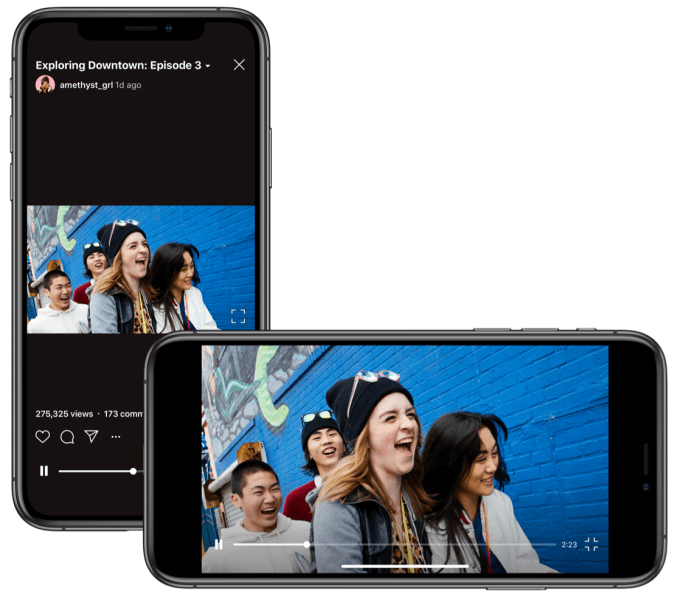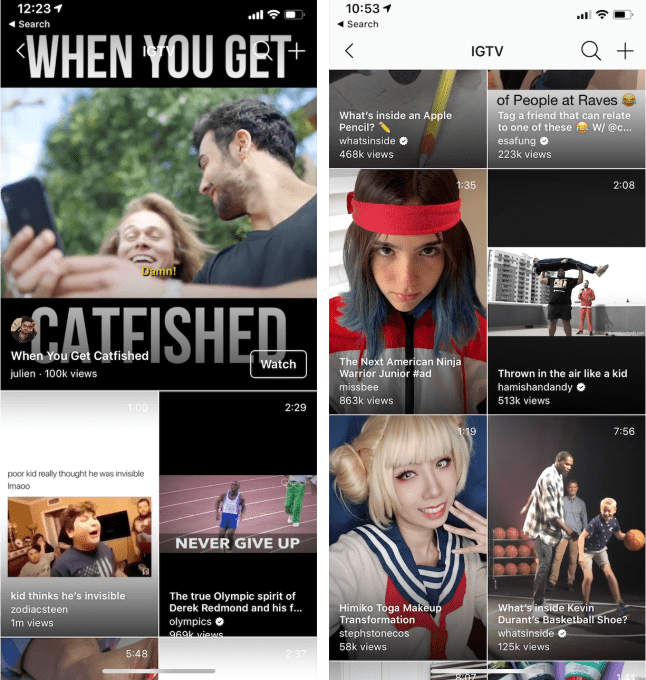A year ago Instagram made a bold bet with the launch of IGTV: That it could invent and popularize a new medium of long-form vertical videos. Landscape uploads weren’t allowed. Co-founder Kevin Systrom told me in August that “What I’m most proud of is that Instagram took a stand and tried a brand new thing that is frankly hard to pull off. Full-screen vertical video that’s mobile only. That doesn’t exist anywhere else.”
Now a dedicated hub for multi-minute portrait mode video won’t exist anywhere at all. Following lackluster buy-in from creators loathe to shoot in a proprietary format that’s tough to reuse, IGTV is retreating from its vertical-only policy. Starting today, users can upload traditional horizontal landscape videos too and they’ll be shown full-screen when users turn their phones sideways while watching IGTV’s standalone app or its hub within the main Instagram app. That should hopefully put an end to crude ports of landscape videos shown tiny with giant letterboxes slapped on to soak up the vertical screen.

Instagram spins it saying “Ultimately, our vision is to make IGTV a destination for great content no matter how it’s shot so creators can express themselves how they want . . . . In many ways, opening IGTV to more than just vertical videos is similar to when we opened Instagram to more than just square photos in 2015. It enabled creativity to flourish and engagement to rise – and we believe the same will happen again with IGTV.”
Last year I suggested IGTV might have to embrace landscape after a soggy start. “Loosening up to accept landscape videos too might nullify a differentiator, but also pipe in a flood of content it could then algorithmically curate to bootstrap IGTV’s library. Reducing the friction by allowing people to easily port content to or from elsewhere might make it feel like less of a gamble for creators deciding where to put their production resources” I wrote.
The coming influx of repurposed YouTube videos could drive more creators and their fans to IGTV. To date there have been no break-out stars, must-see shows, or cultural zeitgeist moments on IGTV. Instagram refused to provide a list of the most viewed long-form clips. Sensor Tower estimates just 4.2 million installs to date for IGTV’s standalone app, amounting to less than half a percent of Instagram’s billion-plus users downloading the app. It saw 3.8 times more downloads per day in its first three months on the market than than last month. The iOS app sank to No. 191 on the US – Photo & Video app charts, according to App Annie, and didn’t make the overall chart.
Instagram has tried several changes to reinvigorate IGTV already. It started allowing creators to share IGTV previews to the main Instagram feed that’s capped at sixty seconds. Users can tap through those to watch full clips of up to sixty minutes on IGTV, which has helped to boost view counts for video makers like BabyAriel. And earlier this week we reported that IGTV had been quietly redesigned to ditch its category tabs for a central feed of videos that relies more on algorithmic recommendations like TikTok and a two-wide vertical grid of previews to browse like Snapchat Discover.
But Instagram has still refused to add what creators have been asking for since day one: monetization. Without ways to earn a cut of ad revenue, accept tips, sign up users to a monthly patronage subscription, or sell merchandise, it’s been tough to justify shooting a whole premium video in vertical. Producing in landscape would make creators money on YouTube and possibly elsewhere. Now at least creators can shoot once and distribute to IGTV and other apps, which could fill out the feature with content before it figures out monetization.
For viewers and the creators they love, IGTV’s newfound flexibility is a positive. But I can’t help but think this is Instagram’s first truly massive misstep. Nine months after safely copying Snapchat Stories in 2016, Instagram was happy to tout it had 200 million daily users. The company still hasn’t released a single usage stat about IGTV usage. Perhaps after seemingly defeating Snap, Instagram thought it was invincible and could dictate how and what video artists create. But the Facebook pet proved fallible after all. The launch and subsequent rethinking should serve as a lesson. Even the biggest platforms can’t demand people produce elaborate proprietary content for nothing in return but “exposure”.
from Social – TechCrunch https://tcrn.ch/2VNyOoY
No comments:
Post a Comment